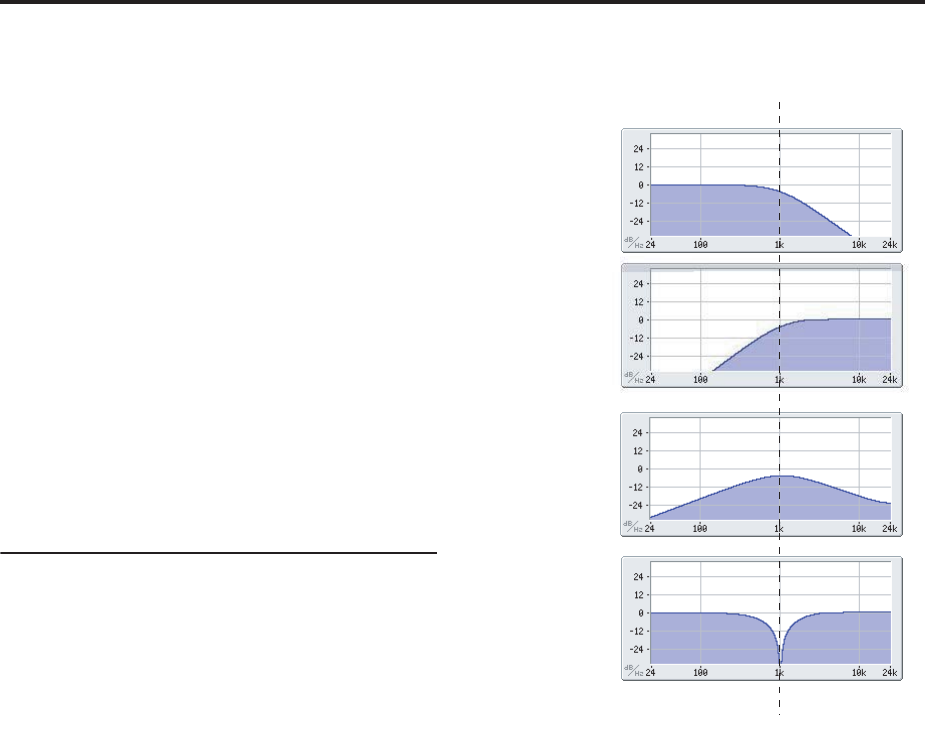
EXi: STR-1 Plucked String
262
Single. This uses only Filter A as a single 2-pole,
12dB/octave filter (6dB for Band Pass and Band
Reject). When this option is selected, the controls for
Filter B will be grayed out.
Serial. This uses both filters. The output of Filter A is
processed through Filter B.
Parallel. This also uses both Filter A and Filter B.
Unlike Serial, above, the outputs of the two filters are
kept separate, with individual control over both level
and pan.
24dB/oct. This merges both filters to create a single 4-
pole, 24dB/octave filter (12dB for Band Pass and Band
Reject). In comparison to Single, this option produces a
sharper roll-off beyond the cutoff frequency, as well as
a slightly more delicate resonance. Many classic analog
synths used this general type of filter.
When 24dB/oct is selected, only the controls for Filter
A are active; the controls for Filter B will be grayed out.
Also, note that the Multi Filter is not available in this
mode.
5–1b: Filter A
Filter Type [
Low Pass, High Pass, Band Pass,
Band Reject, Multi Filter
]
The filter will produce very different results depending
on the selected filter type. The selections will change
slightly according to the selected Filter Routing, to
show the correct cutoff slope in dB per octave.
Low Pass. This cuts out the parts of the sound which
are higher than the cutoff frequency. Low Pass is the
most common type of filter, and is used to make bright
timbres sound darker.
High Pass. This cuts out the parts of the sound which
are lower than the cutoff frequency. You can use this to
make timbres sound thinner or more buzzy.
Band Pass. This cuts out all parts of the sound, both
highs and lows, except for the region around the cutoff
frequency. Since this filter cuts out both high and low
frequencies, its effect can change dramatically
depending on the cutoff setting and the oscillator’s
multisample.
With low resonance settings, you can use the Band
Pass filter to create telephone or vintage phonograph
sounds. With higher resonance settings, it can create
buzzy or nasal timbres.
Band Reject. This filter type–also called a notch filter–
cuts only the parts of the sound directly around the
cutoff frequency. Try modulating the cutoff with an
LFO to create phaser-like effects.
Multi Filter. This is a complex filter which is capable of
all of the above filter types, and many more besides.
For more information, see “5-2: Multi Filter,” on
page 264.
The Multi Filter is available only for Filter A, and only
when the Filter Routing is set to Single, Serial or
Parallel.
Filter Types and Cutoff Frequency
Bypass [Off, On]
This lets you bypass Filter A completely.
If Bypass is Off, Filter A functions normally.
When Bypass is On, Filter A has no effect on the input
signal.
Trim [00…99]
This adjusts the volume level at the input to Filter A. If
you notice that the sound is distorting, especially with
high Resonance settings, you can turn the level down
here, or at the Output Level.
Note that the filter will not clip internally, so there is no
difference between adjusting the Input Trim and the
Output Level. Either of these controls will allow you to
minimize clipping later in the signal chain, such as
may occur in some effects.
Output Level [00…99]
This controls the output level of Filter A. You can use
this to balance the volumes of Filters A and B when the
Routing is set to Parallel, or to turn down the volume
to avoid clipping later in the signal chain.
AMS [AMS Sources]
This selects a modulation source to control the Output
Level. For a list of AMS sources, see “AMS (Alternate
Modulation Source) List” on page 967.
Intensity [–99…+99]
This controls the depth and direction of the Output
Level modulation.
Low Pass
High Pass
Band Pass
Band Reject
Cutoff Frequency


















